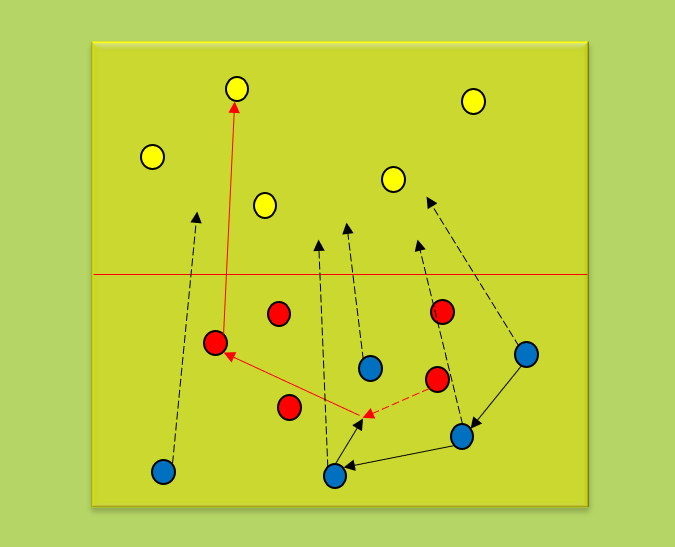Many coaches confuse the term “Possession games” with “Positional games“. Even though in many cases the two types of drills have many in common, the objectives and what exactly each type benefits the team are different. In each type of drill, the coaching points, objectives, way of designing, etc. may vary from small details to huge.
What is Positional Play in simple words?
In the last few years, we have heard the term “Positional Play” more and more. But what is Positional Play? In brief, is the philosophy, methodology of training, and style of play that has as the core of all movements, actions, and the positioning of the players on the pitch. All the actions taken aim to take advantage of the positioning of the players on the pitch.
Many confuse Positional Play with Ball Possession. A team to implement a Positional game does not necessarily need to have high percentages of ball possession. You can get much information on the theoretical point of view from a previous article “Positional Play – Juego De Pocision“

Upgrade your coaching skills with FootballCoach365 Premium! Get expert insights, video tutorials, tactical playbooks, training sessions, and more. Elevate your game – subscribe today.
Elevate Your Coaching Game with FootballCoach365 Premium Subscription!
- 30-Minute Online Session with Our Expert Coach
- “Ask Me Anything” Option
- Premium Exclusive Content
- Complimentary Copy of FC365 book “How to Train Positional Play” for Free
Positional Games
The main definition of the positional drills is the participation of the players being in their specific position trying to complete or learn new tactics related to the position’s functions and responsibilities.
The main goal is to ensure the possession of the ball with a tactical sense through training content. There will always be two teams, with offensive numerical overload.
See below an example of a Positional drill. This is the famous 4 v 4 + 3 Positional Drill that by Pep Guardiola uses a lot. Check the article from Coach Voice Academy on Pep Guardiola’s tactics.
Visit and subscribe to our Youtube channel for more Positional and Possession drills.
During the Positional drill, the teams are playing in the same grid making it as realistic as possible. Even though the primary target is to train attacking concepts, in some cases, positional drills can be used to train defensive behaviors.
The coach designs this type of drill based on his game model. It’s a training tool he can use to pass his philosophy in a game-related way. Usually, the coaches who use this type of drill based their philosophy on short passing, supporting actions, movements without the ball, and positional changes. Usually, there are no goals but arrival in specific zones, or specific behaviors can be used as a grading system.
The positional drills include all 4 phases of the game. That gives a sense of realism. All the actions, due to the tight spaces where usually a positional drill is done, have much intensity. For that reason, it can also be used for physical conditioning purposes. Of course, the coach depending on what exactly he wants to pass to the team on a specific day will choose which phase he wants to focus on in the drill and which principle or sub-principle.
Advantages:
- Specificity in the organization of the space and players in each position near the ball carrier.
- Train the players to understand how to use ball circulation and the advantage they have from their position
- Work indirect the mentality of the players to change minds when losing the ball or when winning the ball
Disadvantages
- Most of the positional drills are used in small spaces which may limit some tactical concepts like long balls in a counterattack, passes behind the defending back line, etc.
- The players will cooperate with the first or maximum the 2nd line of passes. There is no chance to look for 3rd line passes
- Defensively the team will always have numerical inferiority, as there will be neutral players helping the offensive team, which will make even more difficult the coordination of the pressure.
What we can train with the Positional drills
- Players occupy positions in different lines (vertical and horizontal) in regard to the ball carrier. To offer different types of support
- Give width and depth during the attacking phase
- How to generate the different kinds of superiorities like numerical, positional, qualitative, associative
- Patience in ball circulation until identifying the gap to progress forward
- Third man concept
Possession Games
Possession games have as their main intention ball circulation. In an associative game Model, where the relationships between the players and the passing combinations are vital, these types of drills will be necessary to “explain” the value of ball possession. Possession drills like positional drills also have the 4 phases of the game.

Even though in such games there are no official goals, a coach can use small gates to increase the player’s motivation. Also, the gates can be used for the point system or the switch the possession between the teams.
The possession games are useful to train the attacking and defending principles and sub-principles of our game model. Also, there is an option to focus on the conditional structure due to the drill’s nature. Depending on the number of players used in the drill, it can be used on a strength day or an endurance day.
See below an example of a Possession game that has the defensive subject. The target is to train the compact defense. The drill is posted on our YouTube channel.
A possession game can have technical skills objectives and more tactical intentions. An example is a possession game with the tactical intention for the center backs to push forward and create numerical superiorities in the center of the pitch.
Advantages:
- Train specific individual or group behaviors
- Physiological and physical intensity
- Train coordinative abilities specific to the real competition
- The motivation of the players will be high, as the participation and interaction will be constant
Disadvantages
- The free positioning of the players on the pitch does not allow the players to train in specificity
- The development of certain contents does not have real transfer, especially in movements in the attacking third (absence of official goals)
What we can train with the Possession games
- Coordinative skills
- Physical condition (endurance, strength, etc.)
- Cognitive structure – train the player’s mental part
- Develop creativity (players are free to express their ideas and use techniques in an environment that changes constantly)
You do not want to keep using the same old drills. Check Pep Guardiola’s book “PEP GUARDIOLA – 85 PASSING, RONDOS, POSSESSION GAMES & TECHNICAL CIRCUITS DIRECT FROM PEP’S TRAINING SESSIONS” for many Possession drills.
Conclusion
Positional games aim to improve the team from a tactical point of view, especially in the attacking phase. On the other hand, the possession games aim to improve ball possession. Both drills will give the opportunity to the players to interact in a drill with many repetitions in tight areas. A coach can use any type depending on the concept he wants to train.
For more specific tactical subjects, a positional drill will be more useful. In a day where the coach wants to train more general concepts or add physical components using the ball, a possession drill is an ideal option. Also, the number of players that a coach has available is important.
Which type of drill do you prefer? Leave your comment below.

